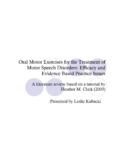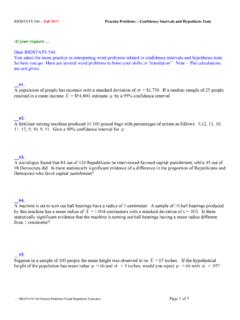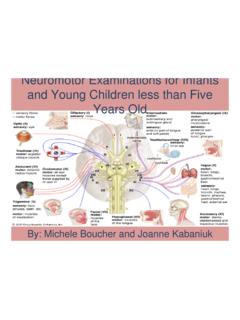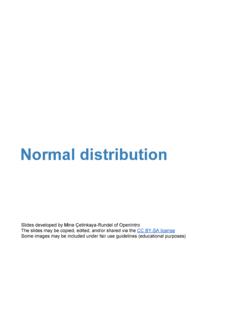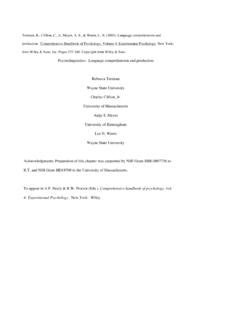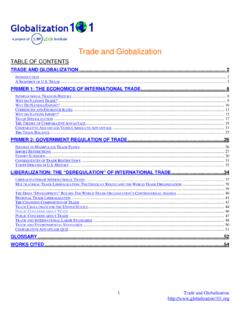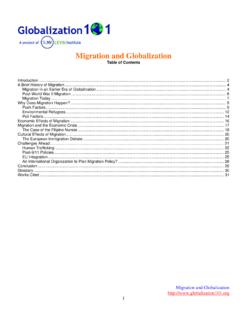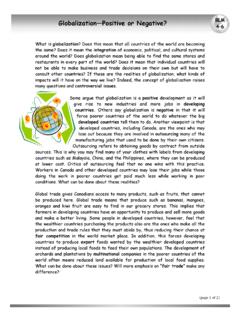Transcription of Globalization and Neoliberalism - UMass
1 Globalization and Neoliberalism by David M. Kotz Department of Economics and Political Economy Research Institute Thompson Hall University of Massachusetts Amherst, MA 01003 Telephone 413-545-1248 Fax 413-545-2921 Email August, 2000 This paper was published in Rethinking Marxism, Volume 12, Number 2, Summer 2002, pp. 64-79. Research assistance was provided by Elizabeth Ramey and Deger Eryar. Research funding was provided by the Political Economy Research Institute of the University of Massachusetts at Amherst. Globalization and Neoliberalism 1 For some two decades Neoliberalism has dominated economic policymaking in the US and the UK.
2 Neoliberalism has strong advocates in continental Western Europe and Japan, but substantial popular resistance there has limited its influence so far, despite continuing US efforts to impose neoliberal policies on them. In much of the Third World, and in the transition countries (except for China), the US has been successful in dictating neoliberal policies, acting partly through the IMF and World Bank and partly through direct pressure. Neoliberalism is an updated version of the classical liberal economic thought that was dominant in the US and UK prior to the Great Depression of the 1930s. From roughly the mid 1930s to the mid 1970s a new Ainterventionist@ approach replaced classical liberalism, and it became the accepted belief that capitalism requires significant state regulation in order to be viable.
3 In the 1970s the Old Religion of classical liberalism made a rapid comeback, first in academic economics and then in the realm of public policy. Neoliberalism is both a body of economic theory and a policy stance. Neoliberal theory claims that a largely unregulated capitalist system (a Afree market economy@) not only embodies the ideal of free individual choice but also achieves optimum economic performance with respect to efficiency, economic growth, technical progress, and distributional justice. The state is assigned a very limited economic role: defining property rights, enforcing contracts, and regulating the money State intervention to correct market failures is viewed with suspicion, on the ground that such intervention is likely to create more problems than it solves.
4 The policy recommendations of Neoliberalism are concerned mainly with dismantling what remains of the regulationist welfare state. These recommendations include deregulation of business; privatization of public activities and assets; elimination of, or cutbacks in, social welfare programs; and reduction of taxes on businesses and the investing class. In the international sphere, Neoliberalism calls for free movement of goods, services, capital, and money (but not people) across Globalization and Neoliberalism 2national boundaries. That is, corporations, banks, and individual investors should be free to move their property across national boundaries, and free to acquire property across national boundaries, although free cross-border movement by individuals is not part of the neoliberal program.
5 How can the re-emergence of a seemingly outdated and outmoded economic theory be explained? At first many progressive economists viewed the 1970s lurch toward liberalism as a temporary response to the economic instability of that decade. As corporate interests decided that the Keynesian regulationist approach no longer worked to their advantage, they looked for an alternative and found only the old liberal ideas, which could at least serve as an ideological basis for cutting those state programs viewed as obstacles to profit-making. However, Neoliberalism has proved to be more than just a temporary response. It has outlasted the late 1970s/early 1980s right-wing political victories in the UK (Thatcher) and US (Reagan).
6 Under a Democratic Party administration in the US and a Labor Party government in the UK in the 1990s, Neoliberalism solidified its position of dominance. This paper argues that the resurgence and tenacity of Neoliberalism during the past two decades cannot be explained, in an instrumental fashion, by any favorable effects of neoliberal policies on capitalist economic performance. On the contrary, we will present a case that Neoliberalism has been harmful for long-run capitalist economic performance, even judging economic performance from the perspective of the interests of capital. It will be argued that the resurgence and continuing dominance of Neoliberalism can be explained, at least in part, by changes in the competitive structure of world capitalism, which have resulted in turn from the particular form of global economic integration that has developed in recent decades.
7 The changed competitive structure of capitalism has altered the political posture of big business with regard to economic policy and the role of the state, turning big business from a supporter of state-regulated capitalism into an opponent of it. Globalization and Neoliberalism 3 The Problematic Character of Neoliberalism Neoliberalism appears to be problematic as a dominant theory for contemporary capitalism. The stability and survival of the capitalist system depends on its ability to bring vigorous capital accumulation, where the latter process is understood to include not just economic expansion but also technological progress. Vigorous capital accumulation permits rising profits to coexist with rising living standards for a substantial part of the population over the However, it does not appear that Neoliberalism promotes vigorous capital accumulation in contemporary capitalism.
8 There are a number of reasons why one would not expect the neoliberal model to promote rapid accumulation. First, it gives rise to a problem of insufficient aggregate demand over the long run, stemming from the powerful tendency of the neoliberal regime to lower both real wages and public spending. Second, the neoliberal model creates instability on the macroeconomic level by renouncing state counter-cyclical spending and taxation policies, by reducing the effectiveness of Aautomatic stabilizers@ through shrinking social welfare programs,3 and by loosening public regulation of the financial sector. This renders the system more vulnerable to major financial crises and depressions.
9 Third, the neoliberal model tends to intensify class conflict, which can potentially discourage capitalist The historical evidence confirms doubts about the ability of the neoliberal model to promote rapid capital accumulation. We will look at growth rates of gross domestic product (GDP) and of labor productivity. The GDP growth rate provides at least a rough approximation of the rate of capital accumulation, while the labor productivity growth rate tells us something about the extent to which capitalism is developing the forces of production via rising ratios of means of production to direct labor, technological advance, and improved labor Table 1 shows average annual real GDP growth rates for six leading developed capitalist countries over two periods, 1950-73 and 1973-99.
10 The first period was the heyday of state-regulated Globalization and Neoliberalism 4capitalism, both within those six countries and in the capitalist world-system as a whole. The second period covers the era of growing neoliberal dominance. All six countries had significantly faster GDP growth in the earlier period than in the later one. While Japan and the major Western European economies have been relatively depressed in the 1990s, the US is often portrayed as rebounding to great prosperity over the past decade. Neoliberals often claim that US adherence to neoliberal policies finally paid off in the 1990s, while the more timid moves away from state-interventionist policies in Europe and Japan kept them mired in stagnation.
